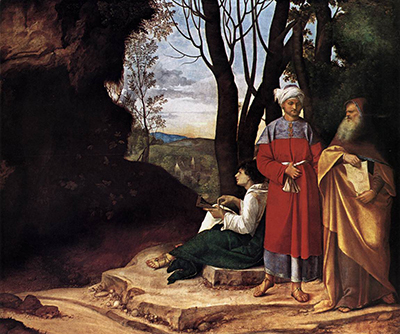Painted c.1509, only a year before the master's death, The Three Philosophers is often considered Giorgione's most mystical work.
It is one of his last paintings and although it was largely completed by Giorgione himself, it is documented that the finishing touches were applied by one of his contemporaries, Sebastiano del Piombo. Commissioned by Taddeo Contarini, a wealthy venetian occultist, “The Three Philosophers” has been said to have many layers of meaning from biblical to esoteric. The original title and subsequent meaning are unknown as the name, The Three Philosophers was acquired from a 1525 description by venetian art critic, Marcantonio Michiel. The painting can be found today in the Kunsthistorisches Museum in Vienna.
Rendered in oils, The Three Philosophers depicts three men; one old, one middle-aged, and the other quite young. According to their dress, it would seem that the old man is Greek, the middle- aged man, wearing a turban, is thought to be Arabic, and the young man is apparently of the renaissance. They are all outside a cave which holds some interest for the young man who is sitting, gazing into dark space while consulting some tools and instruments.
The other two men appear to pay no attention to the cave. All three men are surrounded by nature and in the background, there is a bright town and mountains. Giorgione was a great lover of nature and always found ways to include landscape in his paintings. In fact, nature almost takes pride of place in “The Three Philosophers” as all of the men are standing to one side allowing clear view of the surrounding landscape. Giorgione famously injected great emotion and depth into his work and this is no exception. His skill in blending colour and shade lends an almost poetic feeling to the whole composition, the result is etheric and mysterious.
Giorgione's work was always symbolic and layered with meaning and emotion, but none more so than “The Three Philosophers”. The master’s great gift was to offer the viewer many interpretations, hence this has been a hugely debated painting for centuries.
Of course, there are obvious meanings to be gleaned; those favoured by traditionalists for example, who believe that Giorgione is offering us an interpretation of the Magi outside Jesus' shrine. However, there are many holes in this theory. Firstly, and perhaps most obviously, the fact that the three men are clearly from three different countries and times makes it unlikely that they represent the three kings. Additionally, considering the popular views of the time, the artist’s own humanist bent and the fact that it was commissioned by a man who was renowned for his mystical beliefs, it is hard to reconcile religious illustration alone being the meaning Giorgione intended.
Another simplistic interpretation of the painting is that it merely offers us the three ages of civilisation; ancient Greece, the middle ages and the Renaissance. Alternative religious ideas have also been offered in that it may symbolise the three Abrahamic religions; Christianity, Judaism and Islam. However, with a clear understanding of Giorgione’s body of work the meaning surely has to be more esoteric than this.
The most popular and widely adopted interpretation of “The Three Philosophers” is undoubtable that these three figures are an allegorical story of the history of understanding and enlightenment. The oldest man, generally considered to be Greek, represents perhaps Aristotle or Pythagoras, both fathers of modern philosophy and science. The middle-aged man most likely represents Averroès, a shining light in the Golden Age of Arabic philosophy continuing the quest for knowledge through the ages. The youngest man of course indicates the age of the Renaissance, the coming into the light of science and understanding. To expand on this story, it is thought that the town in the background is indicative of the shining new world coming forth from knowledge and truth. This would seem to be the most complete and feasible interpretation of the painting. However, what is true and undisputed, is that like Giorgione’s other works, “The Three Philosophers”, is thought provoking and inspires debate.
Giorgione’s great skill was not only his choice of subject matter and the masterful depiction of nature, it was his magical use of colour and light. Many of his paintings were believed to have been created in his studio, so it is even more remarkable that he creates a dream-like quality to both characters and landscape alike. Giorgione must have been a man of great depth, as one only has to study his paintings to understand the feelings and emotions he is trying to convey. His easy use of sfumato, the technique of blending shade and light, to create other-worldly poetry in his work, sets him apart as a true master.




